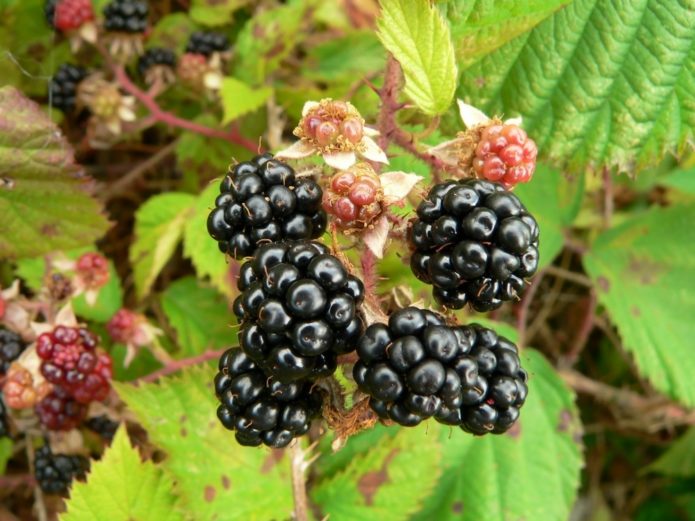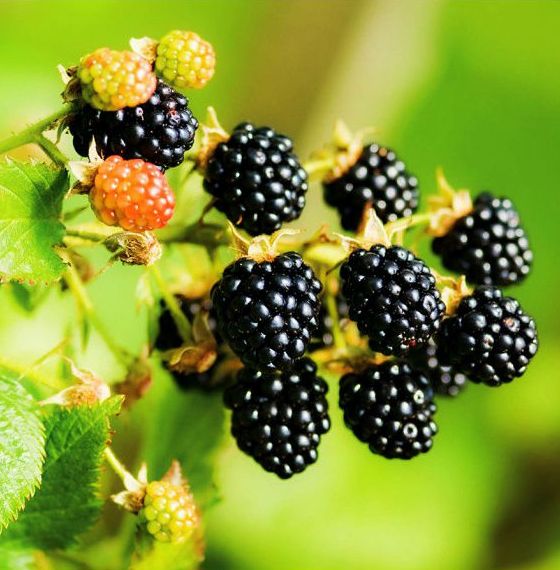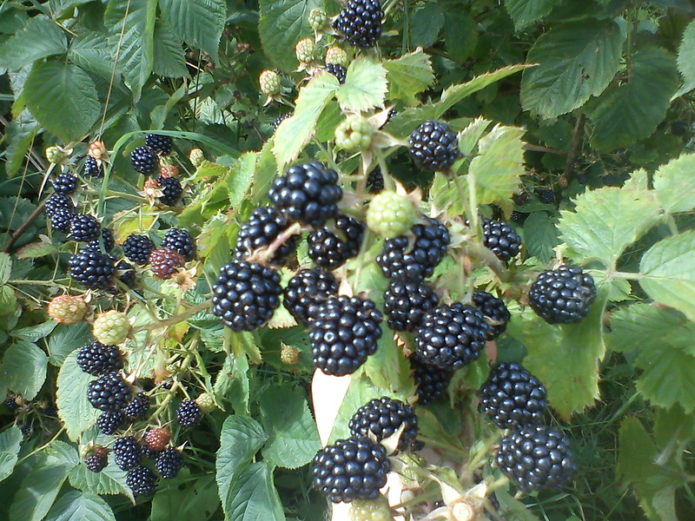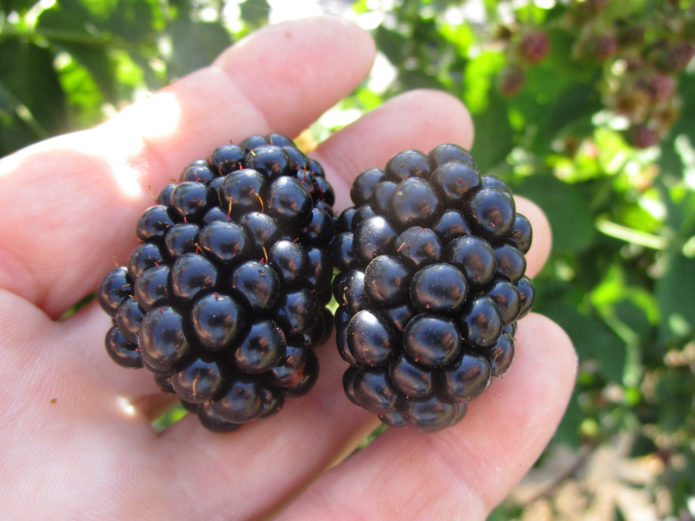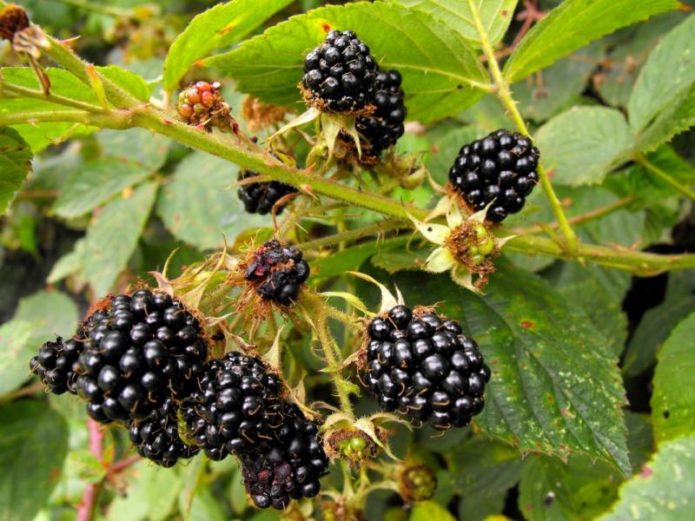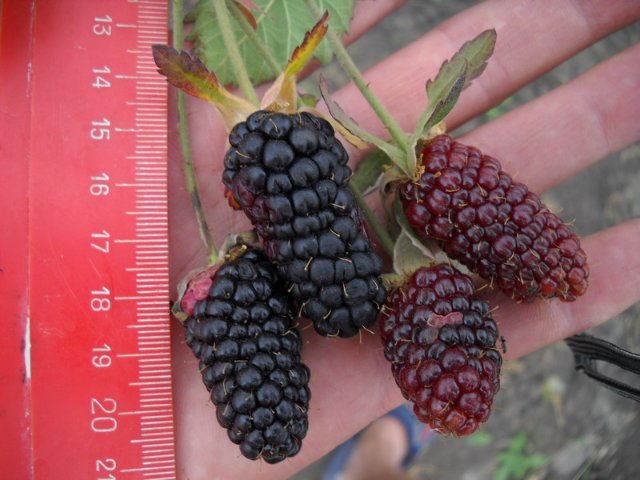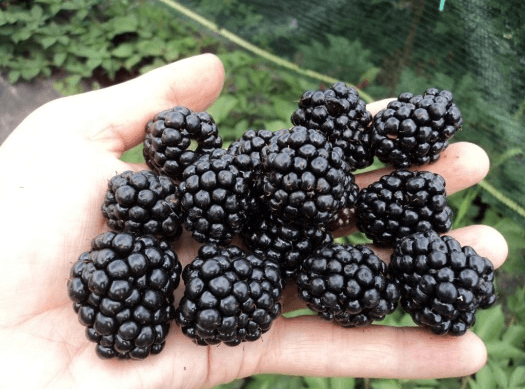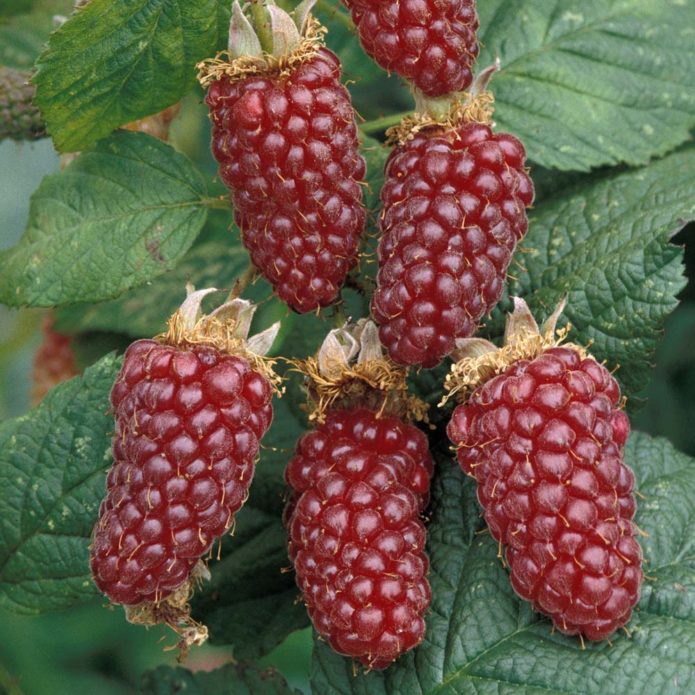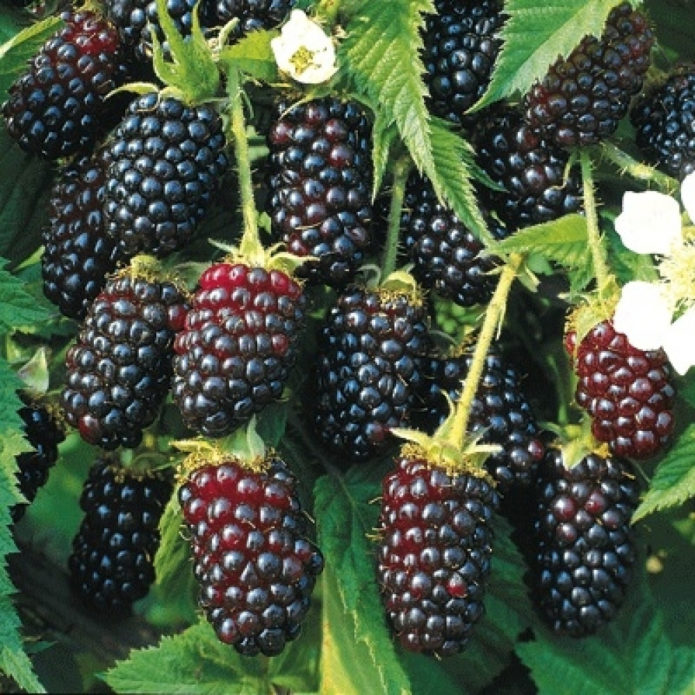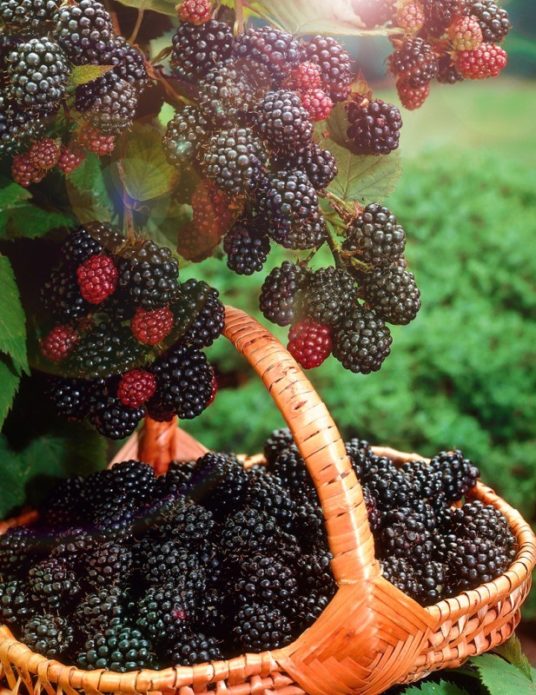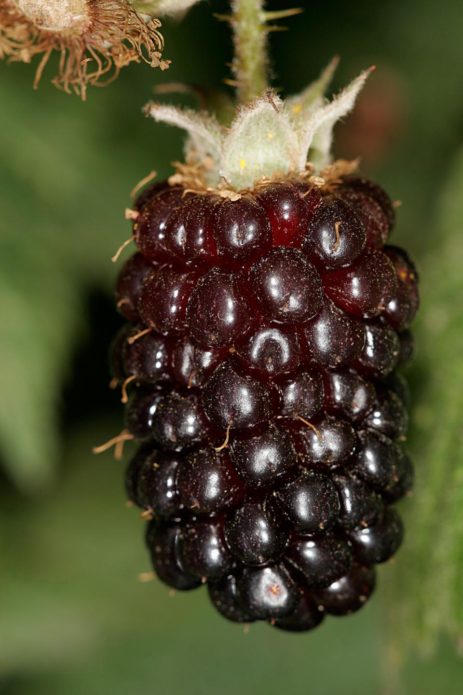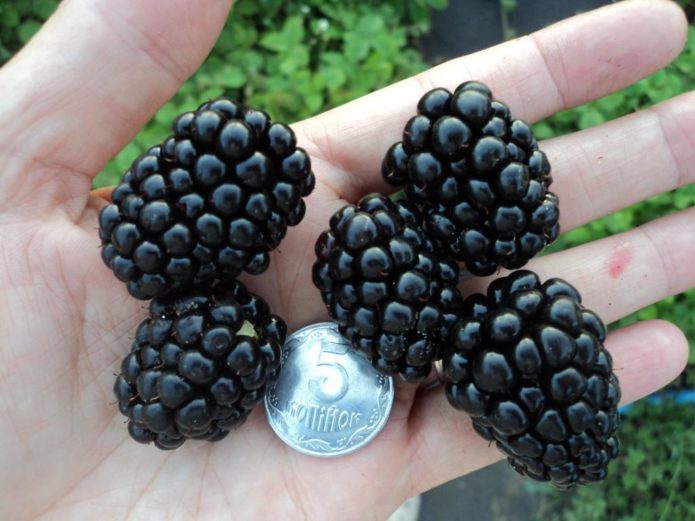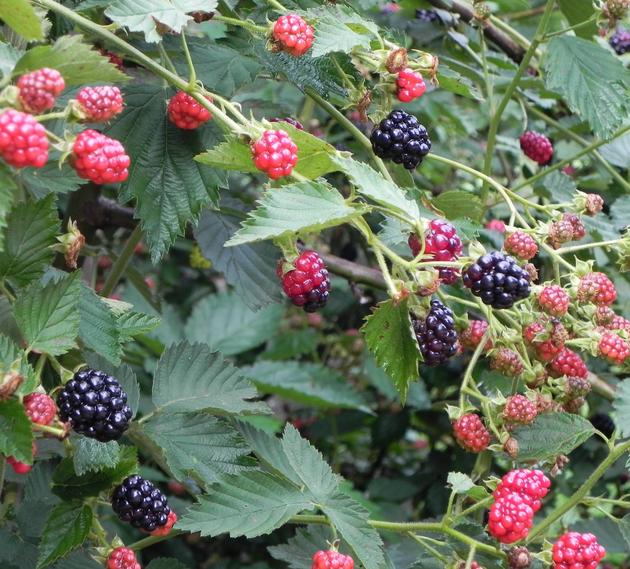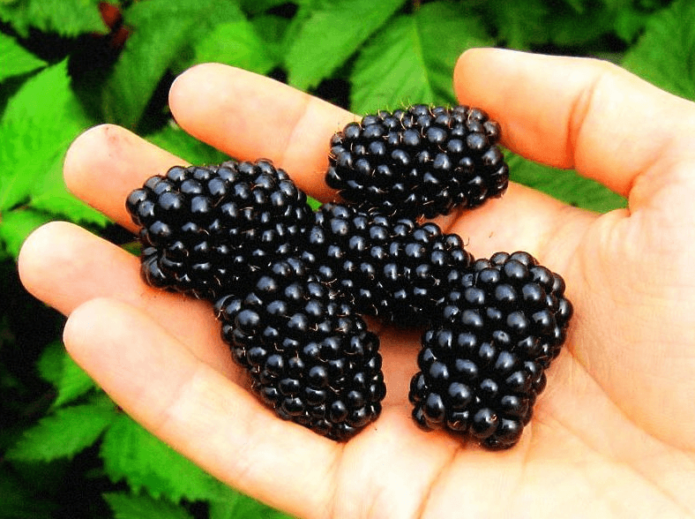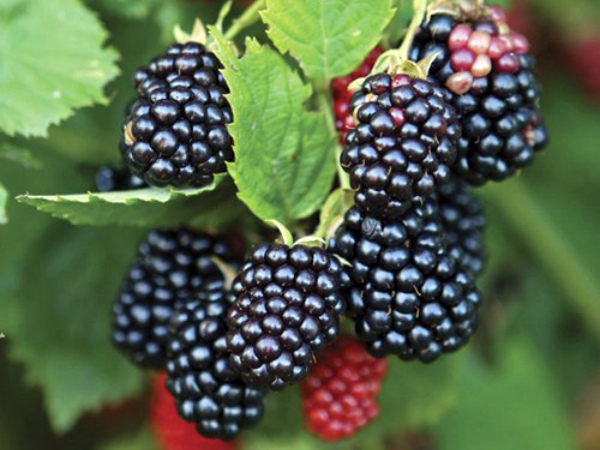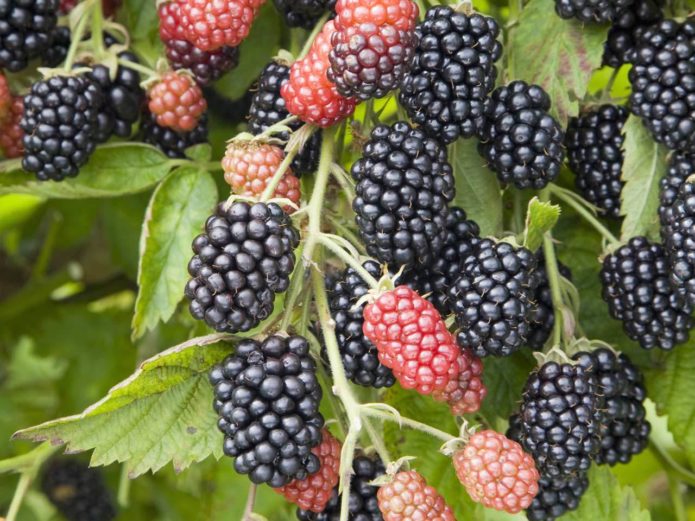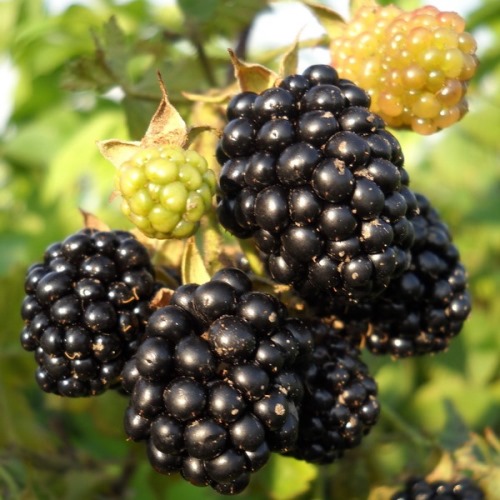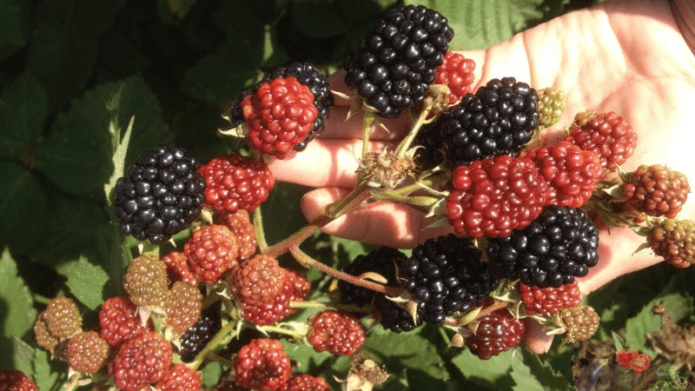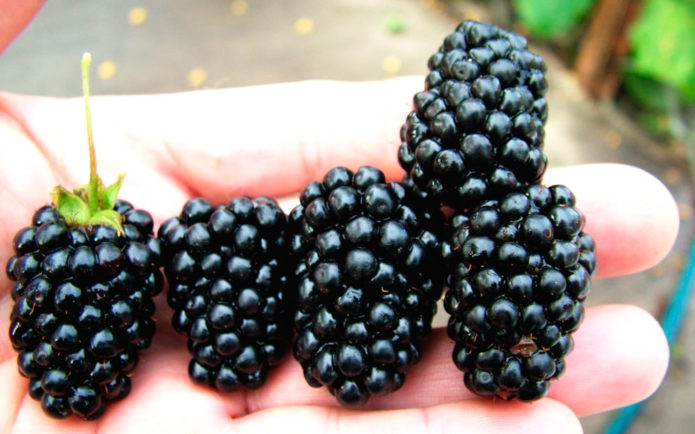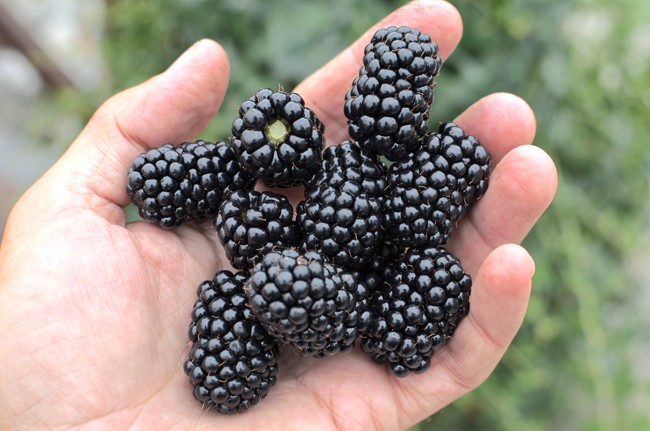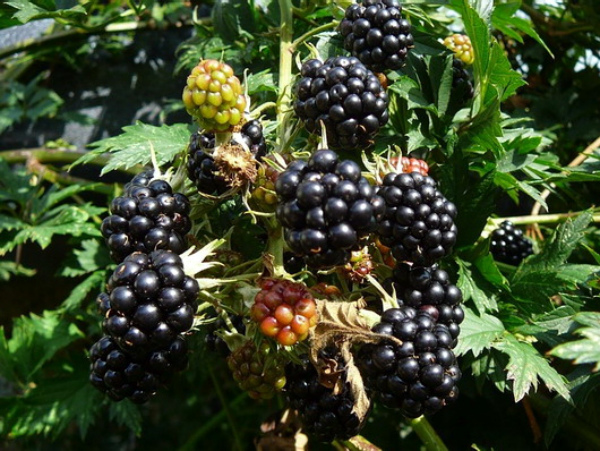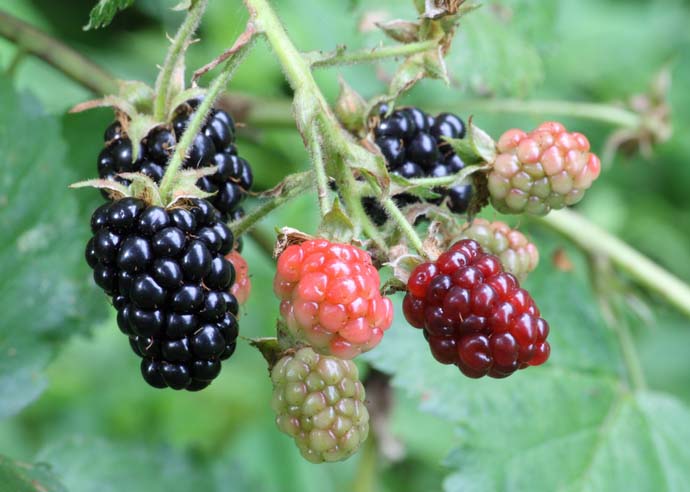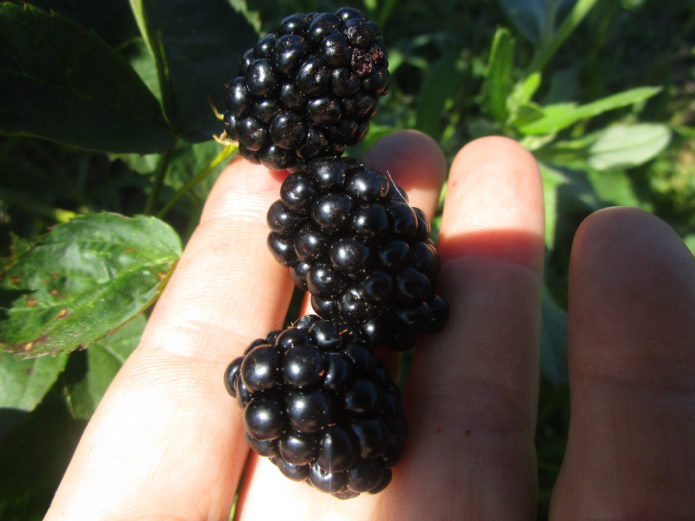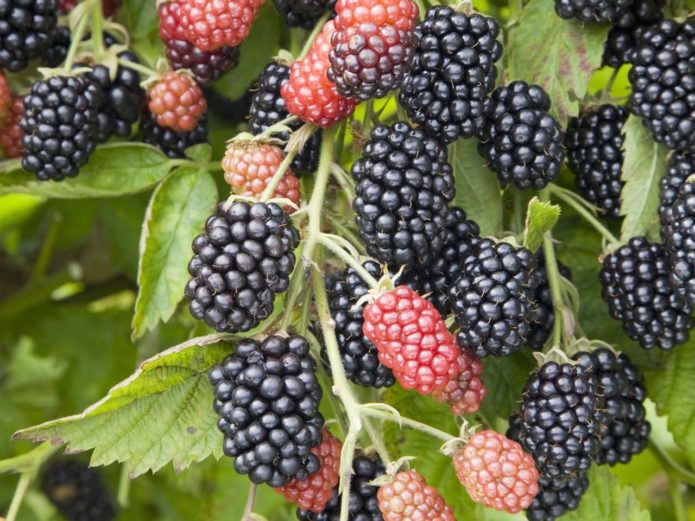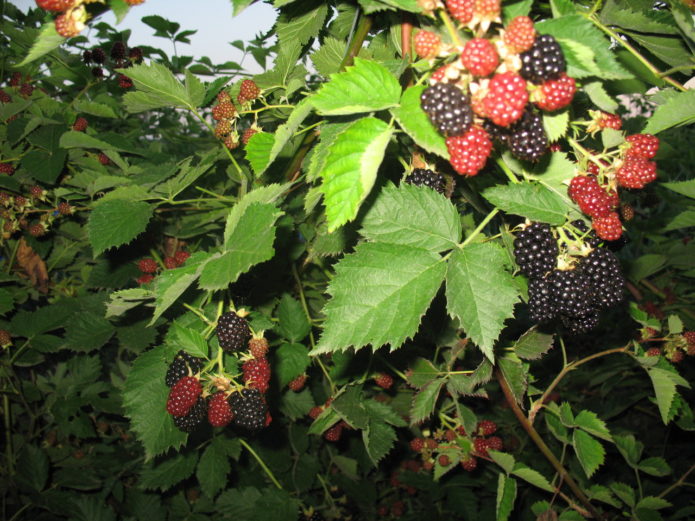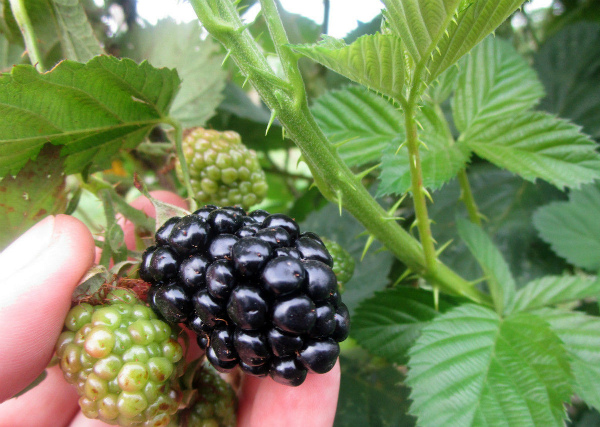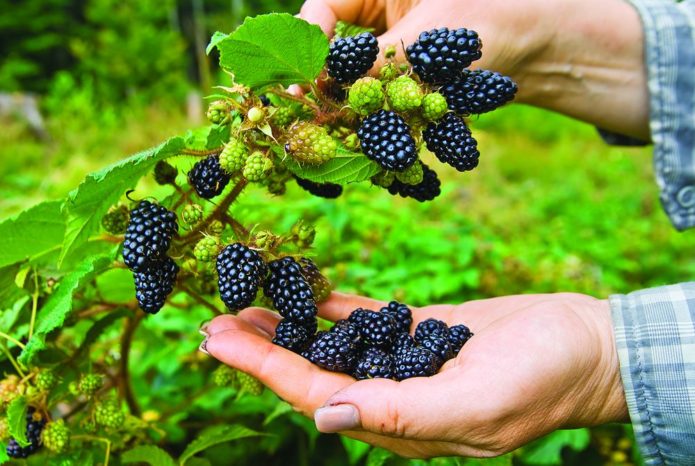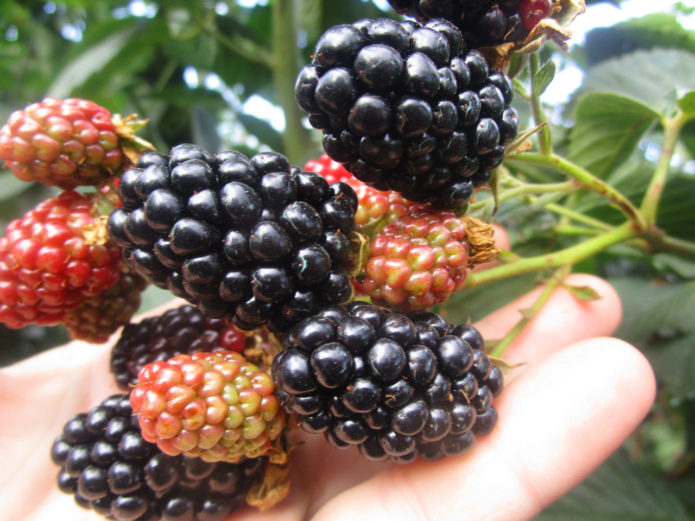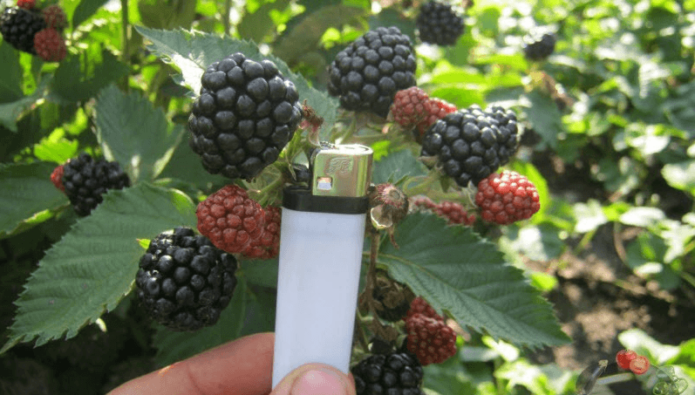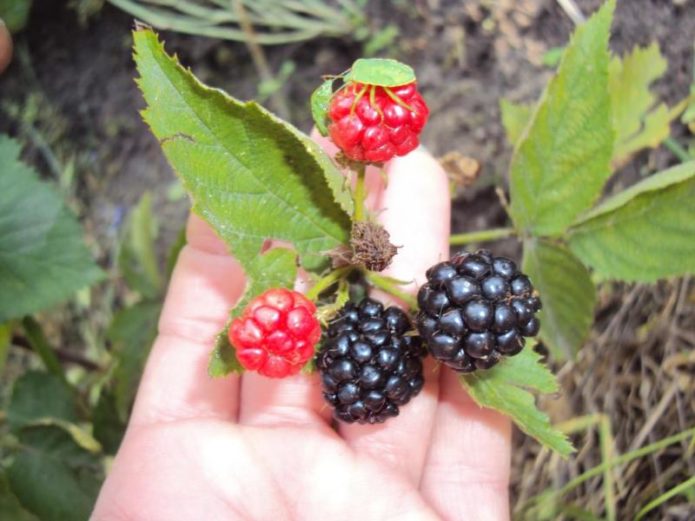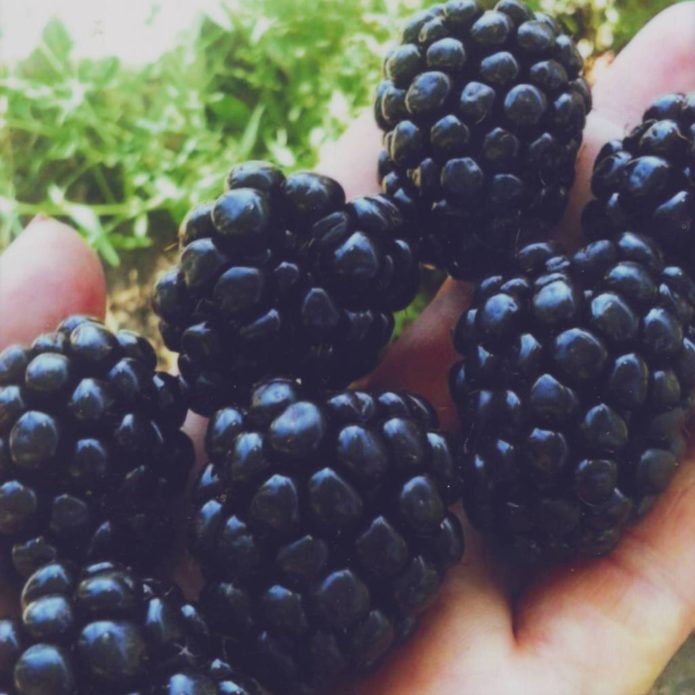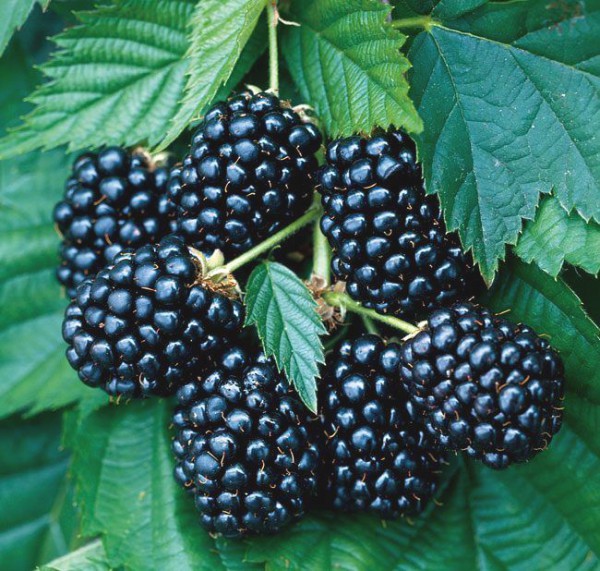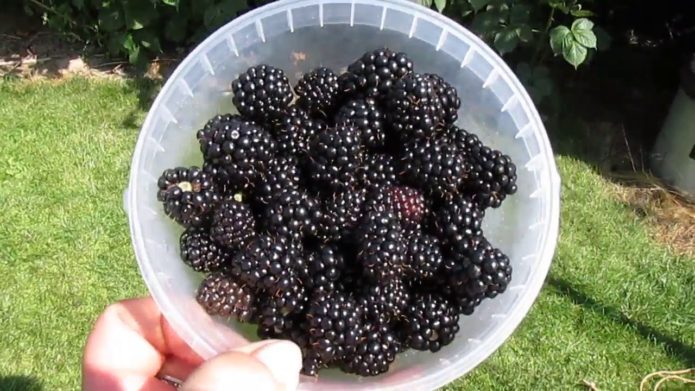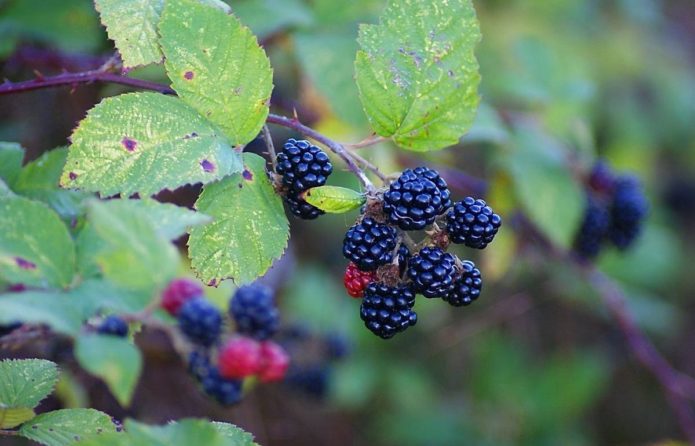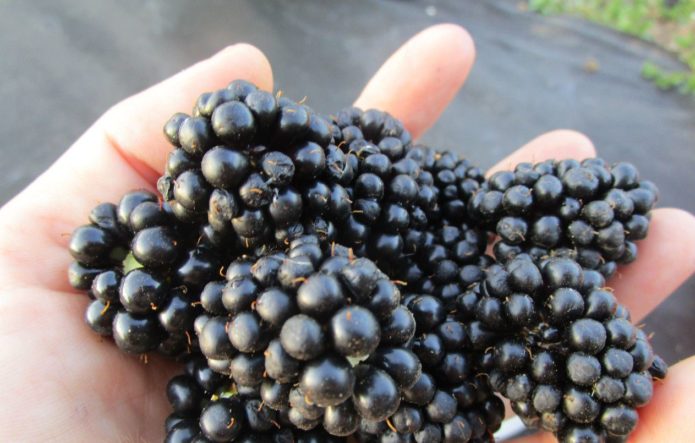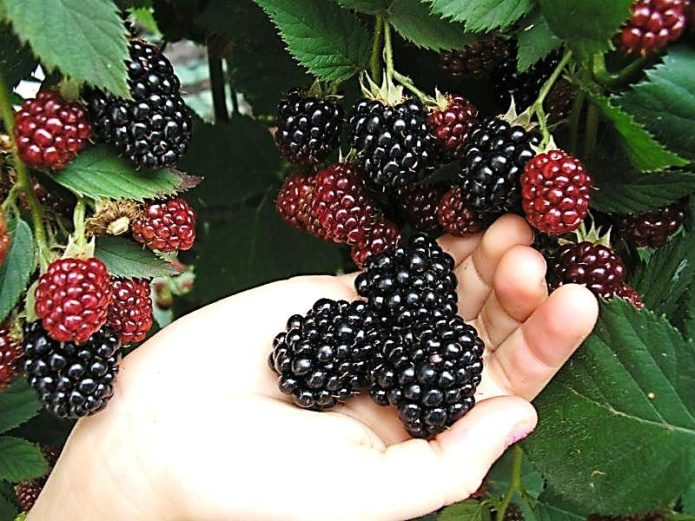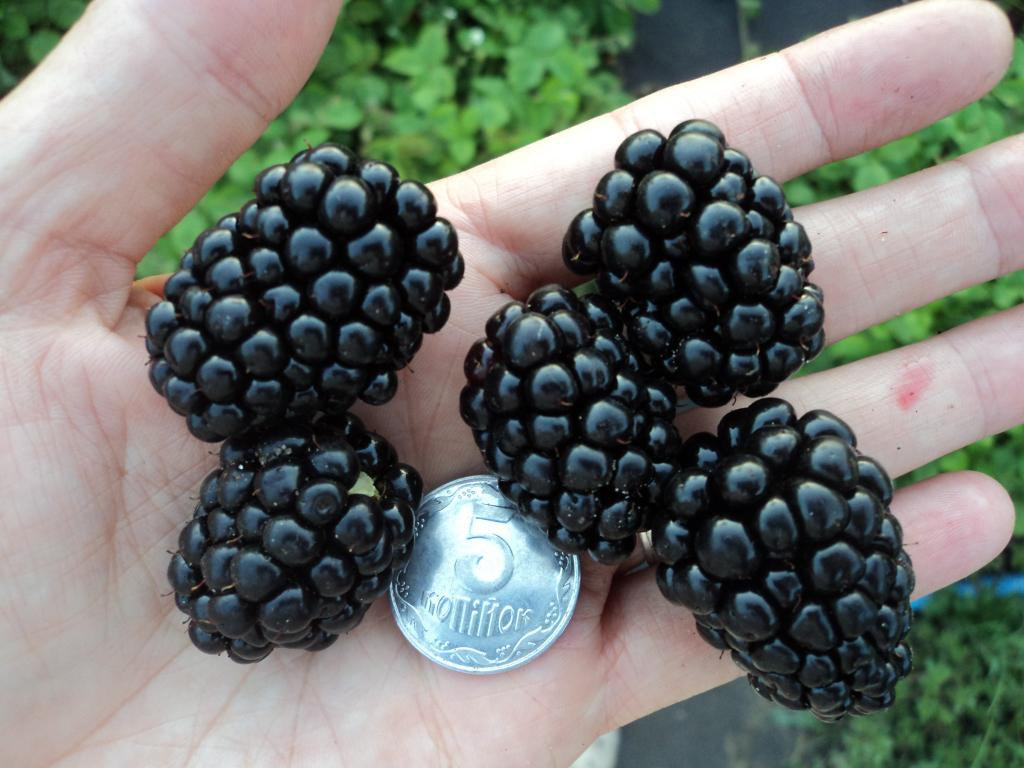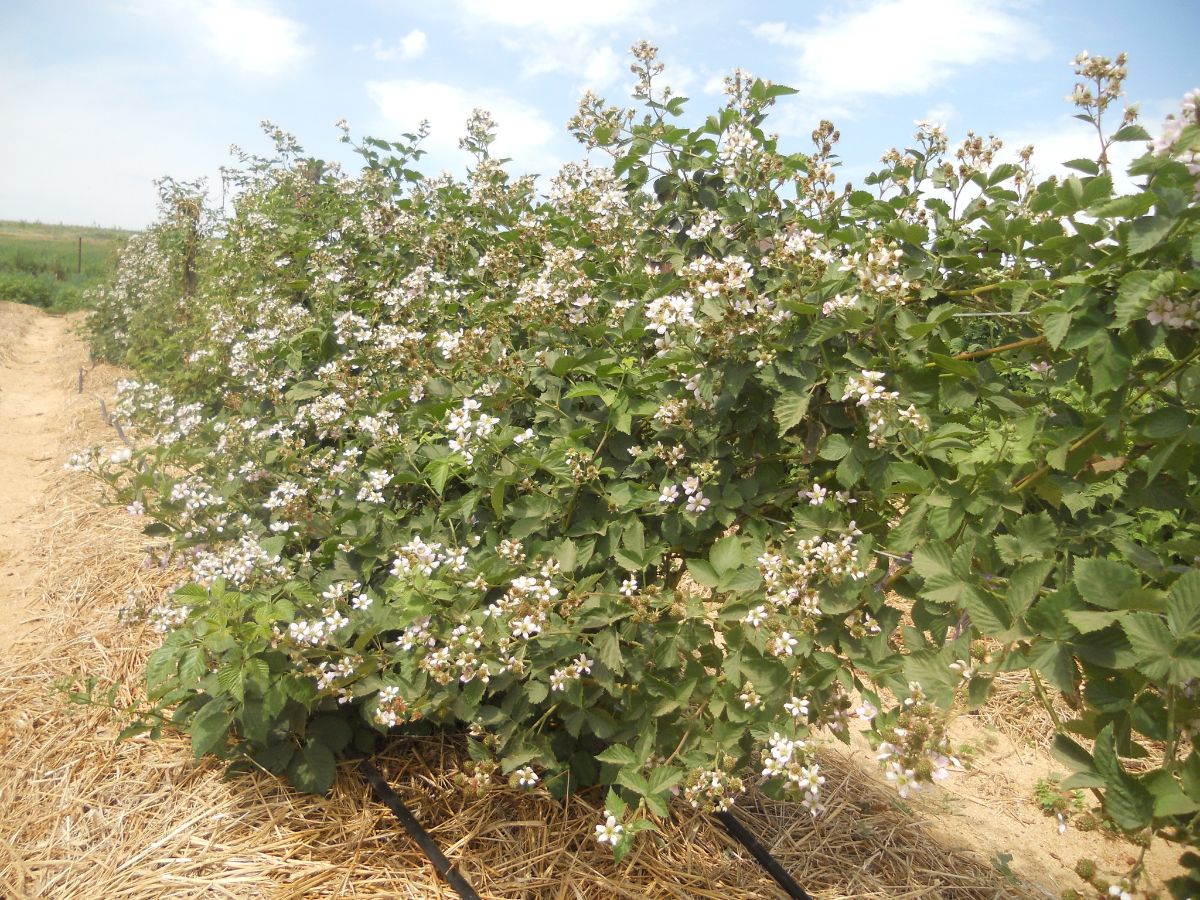More and more summer residents of Russia, Ukraine and Belarus are planting sweet-sour black berries in their gardens - blackberries. Breeders around the world are inventing different and unique varieties: studless, remontant, and even indoor.
Content
Such different blackberries
In the nature of Russia and Europe, there are two types of wild blackberries:
- Rubus caesius - gray blackberry. This shrub, which has ink-colored berries with a characteristic bluish bloom, can reach 1.5 m in height. A feature of the species is also a pubescent stem with small thorns.
- Rubus fruticosus - bushy blackberry. This name hides a set of species of wild blackberries, which are characterized by common features:
- furrowing of an oblong stem,
- burgundy-purple color of shoots,
- long curved spines,
- spherical shape of the fruit.
Garden blackberries are divided into 2 varieties: kumaniku and dewberry.
Differences between kumanik and dew, the nuances of planting and transplanting:https://flowers.desigusxpro.com/en/yagody/posadka-ezheviki-vesnoy.html
Kumanika
Kumanika is a bushy plant with straight, upright shoots. Kumanika has a drawback - the need for pruning. Gardeners often grow this variety using trellises.
The most common varieties:
- A classic example of kumanika is Darrow. The bush is erect, with 2-meter shoots. Begins to yield a harvest 2-3 years after planting. It is extremely resistant to low temperatures, but with the possibility of a snowless winter, it requires a mandatory shelter.
- Apache became a slightly non-standard variety of kumanik. An upright and powerful bush gives up to 5 kg of harvest. The variety was recently bred, its advantages and disadvantages are still being studied.
- Loughton. Blackberry variety is erect, has thorns. The disadvantage of this plant is its extended ripening period.
- Ebony. High-yielding variety (yields more than 10 kg per bush). The bush has straight, vertically directed branches.
- Guy. A variety that has appeared relatively recently (on the market since 2006). Straight shoots reach 3 meters in height. The plant must be sure to cut the lashes.
Rosyanika
The bushes of this plant are creeping and lodging, so the dewdrop does not need support. It reproduces by the apical buds. By the abundance of the harvest, it wins over the kumanik, but the dew grass is not adapted to the cold weather.
- The most common creeping variety is Abundant. The stems are covered with inconspicuous thorns.The advantages of the variety are the possibility of dense planting and high frost resistance.
- Kitatini. Powerful bushes of the variety have creeping stems with an absolute absence of thorns. The berries are large, weighing up to 15 g, have a pleasant sweetness and have a dessert taste.
- Blackberry. The bush has 3-meter stems creeping along the ground with medium-sized thorns.
On the basis of Blackberry, the Black Butte variety was bred, which differs from its parent in a more elegant type of fruit.
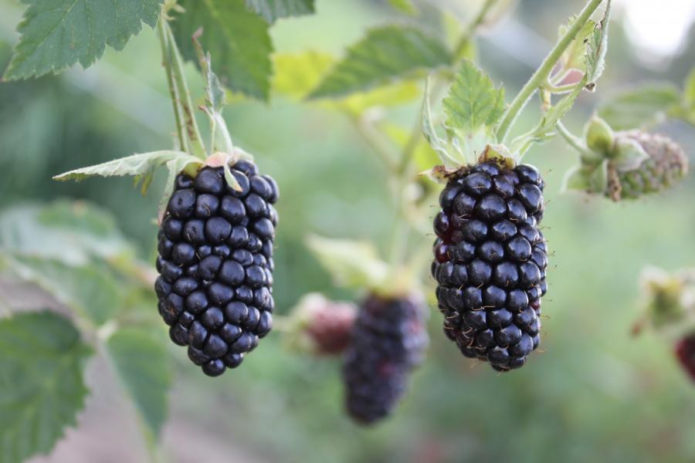
Black Bute berries have a pleasant sweet-sugar taste and can withstand long transportation without any problems
Creeping blackberry
Modern breeders successfully cross dewgrass and kumanik, getting more and more new varieties with creeping stems:
- A classic example of such a blackberry is the Enchantress variety. A plant with a creeping stem, which is decorated with small thorns. Bluish black berries have a purple tint.
- Triple Crown. It is a non-standard example of this variety, since, depending on weather and soil conditions, it can be an upright or creeping bush. The color of the branches is deep emerald. The stem has a characteristic serration. It can grow up to 3 m in length.
List of successful and interesting blackberry hybrids
Breeders consider their property to be ezhemalina or hybrids of blackberries and raspberries:
- Texas. An extremely prolific variety, even with inconsistent care yields an average of 6-7 kg. But the maximum fertility of the bush is 10-12 kg. Texas stems are light brown, up to 3 m in length. Bushes do not give excess shoots (root suckers).
- Tayberry. A distinctive feature of the variety is its crimson creeping shoots with massive thorny branches. The plant has an average yield (5 kg).
- Silvan is similar to Tayberry in its appearance, the only difference of the first steel brush, in which the number of berries can reach 12. The weight of the fruit is quite large - up to 14 g.
- Blackberry Cumberland. If the Tayberry variety is more like a raspberry in its characteristics, then the Cumberland is like a blackberry. Ink-colored berries, weight - 2-3 g. The plant is vigorous and very prickly. The bush consists of massive bare shoots. Cumberland cannot grow without support.
- Boysenberry (or Boysenberry). For the unique combination of berry quality with their taste and aroma, the Boysenberry variety is deservedly considered the best hybrid creation of breeders. When it was first bred, the plant had a large number of thorns. But after a while Boysenberry was improved, and now he pleases gardeners with the absence of thorns.
The most unpretentious varieties
When it comes to planting and choosing a place for blackberries, all gardeners rush to look for bright places in the garden. But there are not so many of them, and you need to plant not only blackberries. The solution to the problem is shade-tolerant varieties.
Shade-tolerant varieties
Loch Tei is considered one of the shade-tolerant varieties, but its long, studless, creeping stems require support or trellis.
The Black Prince variety became the most shade-loving blackberry. The plant is distinguished by straight, vertical shoots with underdeveloped spines. The bush itself is very compact.
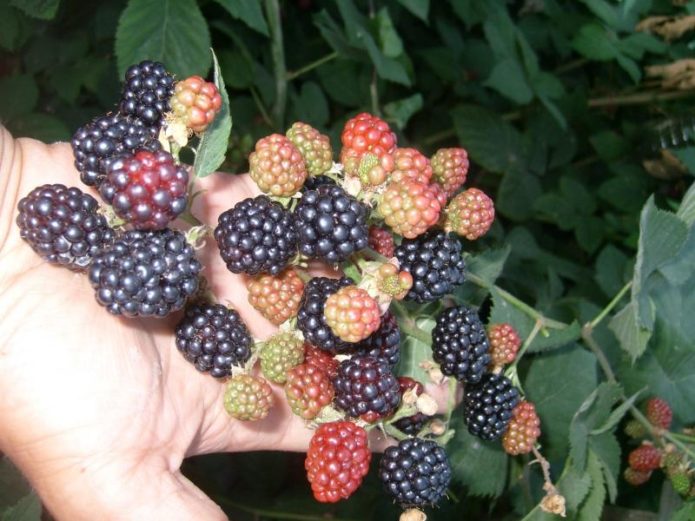
The fruits of the Black Prince weighing up to 10 g have a delicate sweetish taste and a pleasant dessert aftertaste
Top 5 frost-resistant blackberry varieties
Cold winters require hardy varieties that can withstand frost:
- In last place in terms of frost resistance is the Arapakho variety, withstanding up to -24 ° C. The bushy plant has vertically directed stems up to 1.5 m long.
- The fourth place in the top is occupied by Cacanska Bestrna, which is able to withstand cold temperatures down to -26 ° C. The plant is thornless, creeping, with 3-meter stems.
- Shared with the previous variety the fourth place is the Chester variety, which is able to withstand temperatures as low as -26 ° C. The plant is distinguished by 2-meter thornless creeping shoots, that is, it requires support. The variety is very fertile, can yield up to 20 kg per bush.
- In third place in terms of winter hardiness is Polar - a variety that can withstand frosts down to -30 ° C. In a snowless winter, it requires shelter. A bush with vertically directed branches up to 2.5 m in height. The undoubted plus of the variety is the complete absence of thorns.
- The already described Darrow variety is resistant to temperature drops down to -35 ° C and ranks second in the top.
- In the honorable first place was the Flint variety, which will not only withstand frosts down to -40 ° C, but also withstand the threat of pests and fungal diseases. Flint is a plant with upright, upright shoots, which are approximately 3 m long. There are few thorns.
Studless grades
When caring for blackberry bushes thorns cause the most difficulties. Therefore, breeders around the world were actively engaged in varieties that would not have this disadvantage. And the first successful breakthrough was the varieties of the Thornless group - all varieties that did not have thorns were combined into it.
It became inconvenient to say Thornless all the time and add the name of the variety, so now most of the known thornless varieties do not have this prefix.
Popular thornless varieties:
- Ouachita (or Voshito). Plant with strong, upright stems that do not have thorns.
- Smutstem. The very first studless variety that American scientists developed back in the 60s of the XX century. The bush has creeping stems of 3 meters in length. The variety is very prolific, producing about 17 kg per bush.
- Natchez. One of the most famous studless varieties. 3-meter plant with straight hanging shoots. The bush requires support. The fertility of the variety is high, up to 20 kg per bush.
- Loch Ness. It is good not only for the absence of thorns, but also for the high fertility of the bushes, which can reach 25 kg. The creeping shoots of the variety are grown on supports or trellises, since its stems can reach 4 m in length.
- Blackberry Thornless Evergreen. It is studless, but the main feature of the variety is that it does not shed its foliage in autumn, and therefore gardeners can enjoy a beautiful emerald color in spring. The plant spreading along the ground can reach 6 m in length.
- Blackberry Osage. One of the newest thornless varieties, distinguished by its strong and powerful branches.
- Doyle. It is considered the most fruitful thornless variety, which gives up to 7 buckets of berries. A plant with vertically oriented stems up to 6 m long. It is better to grow this bush on supports or trellises.
The best varieties of thornless blackberries and the peculiarities of their cultivation:https://flowers.desigusxpro.com/en/yagody/sorta-ezheviki-besshipnoy.html
Blackberry varieties for different regions
Each region has its own climatic characteristics, and this must be taken into account when choosing a plant variety.
For central Russia
Blackberries for central Russia should be highly resistant to cold weather, as well as high drought tolerance. The following varieties will be good for this region:
- Rushay (or Stream). A variety that does not produce overgrowth and is distinguished by vigorous, powerful, thornless stems.
- Cherokee. The plant is vigorous, without thorns. In a snowless winter, it requires shelter. Extremely prolific variety - up to 15 kg per bush.
Gardeners in central Russia will also be interested in:
- Black Bute,
- Orcan,
- Guy,
- Loch Tei,
- Polar,
- Natchez,
- Apaches,
- Aropajo.
For the Moscow region
Since, in fact, the Moscow region is part of the central zone of Russia, the climatic conditions are similar. Consequently, summer residents of the Moscow region will like varieties that are resistant to all kinds of weather conditions:
- Balm. The bush has vertically directed strong shoots. Plants need support. The undoubted advantage of the variety is the absence of thorns.
- Columbia Star. Little known because of its recent appearance in nurseries. It has vigorous (up to 5 m long) shoots spreading along the ground. Pleases the complete absence of thorns.
Also good for the Moscow region:
- Waldo,
- Apaches,
- Cumberland,
- Darrow,
- Doyle.
For Tver and the Tver region
Tver gardeners will surely like the following varieties:
- Bestberry, although prickly, but its berries are large and smell very tasty. The bush has long stems creeping along the ground.
- Kiova (or Kiowa) is famous for its high yields (almost 30 kg per bush). The plant is characterized by 2-meter vertical shoots, which, due to their length, require support.
Gardeners of Tver will also appreciate the varieties:
- Polar,
- Darrow,
- Flint,
- Chester,
- Chachanska Bestrna.
For Ukraine
Suitable for climatic conditions of Ukraine:
- Nasoloda. Semi-lying bush with strong shoots without thorns.
- Heaven can wait. The variety is characterized by vertically-oriented stems up to 2.5 m long. The main advantage is the taste of berries - an incomparable gradually revealing sweetish taste with a piercing final note of sourness.
And also residents of Ukraine will appreciate:
- Asterin,
- Loch Ness,
- Gradan,
- Loch Merry,
- Loch Tei.
For the Kharkiv region
Kharkiv region of Ukraine is distinguished by a special north-western climate. And it requires special varieties. For instance:
- Thornfree. It is famous for its long lifespan (up to 30 years) and amazing berry taste.
- Jumbo. Compact bushes attract gardeners with tall and strong shoots and an absolute absence of thorns.
Gardeners of the Kharkov region can also pay attention to the varieties:
- Asterina,
- Darrow,
- Doyle,
- Apaches,
- Abundant,
- Triple Crown.
For the North-West region of Russia
The Northwest region of Russia is characterized by dry, cold winters, so all blackberry plants grown in this region require shelter. The following varieties are suitable:
- Waldo. A variety that gives not only bountiful harvests, but also undemanding to the formation of a bush. The plant has 2-meter thornless shoots that spread along the ground.
- Dirksen. It is famous not so much for the absence of thorns on its vertical 3-meter shoots, as for the versatility of the use of berries. The fruits are equally good both fresh and in various preparations, baked goods, jelly.
For gardeners of the North-West will also be interesting:
- Apaches,
- Polar,
- Cumberland,
- Darrow,
- Chester.
For the Leningrad region
In the Leningrad Region, gardeners will surely like the Brzezina variety, a distinctive feature of which is the correct sweet taste of berries and the complete absence of overgrowth. The plant looks like a shrub with vertically oriented 3-meter shoots.
The Taylor cultivar is a vigorous, weakly thorny shrub with vertical shoots.
Summer residents of the Leningrad Region will delight:
- Aropajo,
- Chachanska Bestrna,
- Kiova,
- Thornless Evergreen.
For the Urals and Siberia
Siberia and the Urals require varieties that will be able to withstand their climatic conditions. You can choose Darrow, Flint, Polar, and also:
- Choctaw. A 1.5-meter, vertically oriented bush, covered with small thorns and small berries, the weight of which does not exceed 5 g.
- Bronco Delicato (or Brombo Delicato). The variety is characterized by straight spiked shoots.
- Find. The stems of the variety creeping on the ground can bear more than 6 kg of fruit. The berries are medium-sized, weighing up to 10 g.
For Belarus
The climatic features of Belarus lead gardeners to search for suitable varieties. Suitable:
- Loch Merry (or Loch Marie). It is famous not only for its high commercial qualities, but also for its beautiful delicate flowers. It is because of them that the variety is often used for design and decorative purposes.
- Asterina. It differs not only in its compactness, but also in the increased sweetness of the berries. The bush has vertical, absolutely non-thorny shoots.
- Gradan. Creeping plant with 2-meter studless shoots.
Also, gardeners of Belarus will be interested in varieties:
- Jumbo,
- Loch Tei,
- Loch Ness,
- Orcan,
- Sylvan.
For the Volgograd region
For the arid climate of the steppes of the Volgograd region, blackberries are needed that are resistant to prolonged heat. This requirement is met by:
- Himalayas. The cultivar has erect stems that curve towards the ground and therefore requires support.
- Chief Joseph. A vigorous bush with thornless, spreading shoots requires regular pruning.
- Helen. A creeping plant with mighty 2-meter stems.
And also Volgograd summer residents will be interested in the following varieties:
- Smustem,
- Kiova,
- Black Prince,
- Asterina,
- Ouachita.
Blackberry remontant
Repaired blackberries will allow you to enjoy the berries twice - in July and August. For regions where recurrent frosts are frequent and cold starts early, it is better not to use remontant varieties.
Pruning remontant blackberries, when and how best to do it:https://flowers.desigusxpro.com/en/yagody/obrezka-ezheviki-kogda-i-kak-pravilno-ee-delat.html
- Garden Delight.Thornless 1.5-meter bushes of this variety do not need a trellis and will present their owners with dense sweet berries until the end of September.
- Prime-Ark Freedom. The name of this variety is often abbreviated, abbreviated as Freedom. This introduces confusion, giving the impression that there are two varieties. For Prime-Arc Freedom, 2-meter bushes with a complete absence of thorns on straight shoots are characteristic. This variety boasts high yields and large sugar fruits. Freedom is poorly resistant to frost.
- Ruben (Reuben). The medium-sized shoots of the Ruben variety are covered with thorns. But the good news is that at a temperature of -15aboutA covered plant will preserve the harvest without loss.
- Black Magic (Black Magic). On the straight 1.5-meter shoots of the Black Magic variety, not very many thorns will try to prevent the picking of 7-10 gram berries. This variety does not tolerate frost well and therefore needs shelter. In the heat and drought, Black Magic continues to delight with an abundance of fruits.
- Prime Arc 45. Hot and dry summers with good care will not be an obstacle to getting tasty fruits. Erect bushes will slightly upset with the presence of thorns and a high need for shelter for the winter.
- Traveler (Prime-Ark Traveler). He came to us relatively recently from America, so he is still little known in Russia. 7-8-gram berries delight with sweet and sour taste, and the stems - the absence of thorns.
Video: Blackberry Repair Prime-Arc Freedom
Unique balcony blackberry variety
Thanks to modern achievements in breeding, blackberries can now be grown directly in the apartment. Meet Black Cascade - a variety of room (or balcony) blackberries, which is characterized by ampelous growth of shoots. The stems do not have thorns, and in the fall the bush will demonstrate its bright crimson leaves to exotic lovers.
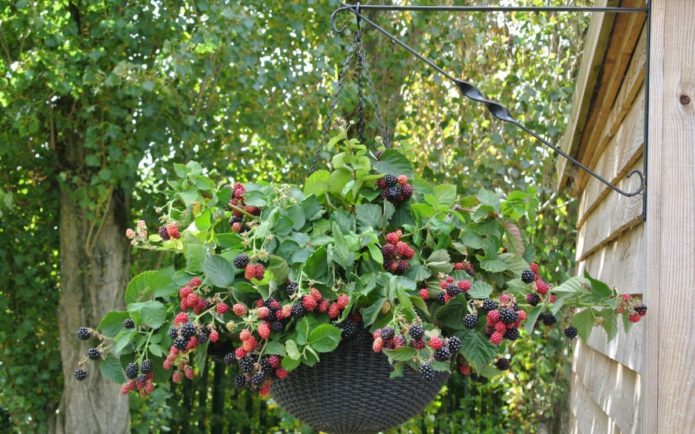
The creator of the variety, John Clark, assures that everyone can grow an appetizing sugar berry on their balcony
Gardeners reviews
Blackberries are, first of all, a delicious berry. And the beneficial properties of blackberries are no less strong than those of raspberries, it is just traditionally believed that raspberries are tastier and sweeter. Ripe blackberries can also be seen immediately, the berries are red at first, then darken, become completely dark - ripe. Blackberries are not only delicious, very healthy, they say that they are a natural substitute for aspirin, and perhaps they are. In any case, blackberry jam, like raspberry jam, is always in the house not just a delicacy, but also a little medicine. They use everything in it: leaves, twigs, and berries. The berry normalizes blood pressure, tea from the leaves is used as a sedative for various nervous disorders. And the leaves, which have astringent properties, are also used for indigestion, here is such a home doctor. Thornfree is a late-ripening, thornless variety, the bushes need to be propped up more than once so as not to lose the berry. The shoots of this variety are thick, solid up to 5–3 cm, dark green, faceted at the base, without thorns, growing up to 5–6 m. If you plant blackberries along the fence, using it as a support, a narrow strip of land will be enough for the plant, and you will have additional protection from unwanted penetration, and beautiful, besides. A blackberry with large thorns can generally be used to create hedges, everyone has different neighbors.
In our conditions, ripe Black Satin berry is sweet and very marketable - we sell several dozen kg per day. There is a fairly large selection of earlier sweet-berry varieties for cool, wet summer regions.
Of the repairmen, I have Black Magic, Prime Arc 45 and Prime Freedom. The first two in the first year gave an excellent harvest of a very large tasty berry. We gave about 60% of the harvest, but this is the first year, besides, spring and early summer were rainy and cold. Hopefully there will be more returns next year. But for the northern regions, perhaps these are not entirely suitable varieties, especially since there are a lot of early ones.
The Agavam variety is unpretentious. Let's see how he gets through this winter. The previous ones were very soft. Yields a lot of delicious berries, when no others are expected (all September). Some disadvantages: strong roundness (work with gloves), the desire to capture all the "tasty" land (it is desirable to limit).
In fact, I planted a thornless blackberry, and after three years it gave a crop and was strewn with berries, but it was so late that I managed to taste about ten berries, and the rest went green in the winter. It was so offensive. Apparently, in my conditions, something earlier is needed. I already agree to prickly varieties. But that at least in August they began to mature.
There are many varieties of blackberries, and each of them is individual and unusual. When choosing a gardener, you need to rely on your preferences and the conditions of the region. Even if the requirements are high and the weather conditions are harsh (for example, in central Russia, in the Urals, in the north-west of the country), there will certainly be a suitable variety. Some enthusiasts even grow blackberries in the apartment.
